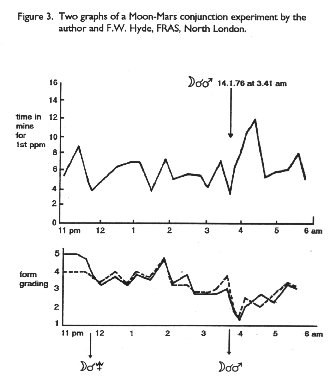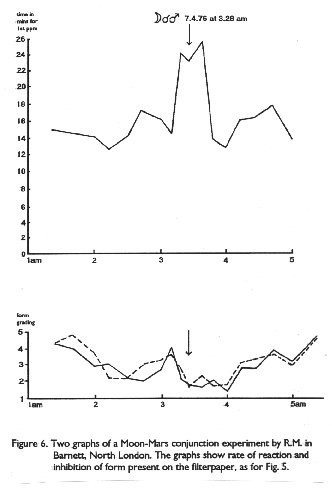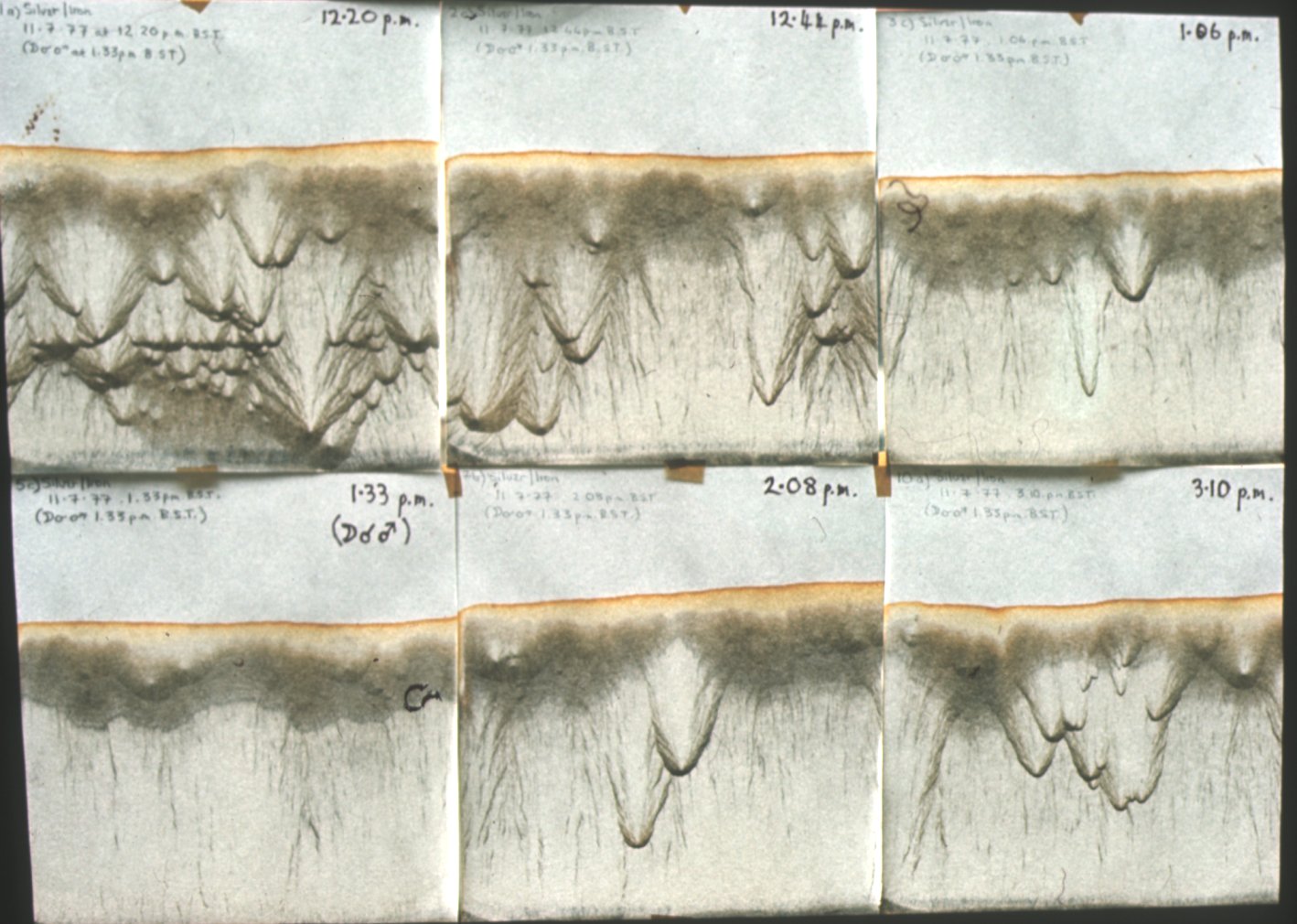- Metal-Planet Correspondences
- A Chemical Theatre
- Moon-Mars Experiments
- Mars-Saturn Experiments
- Moon-Saturn Experiments
- Gold and the Sun
| Moon - Mars Experiments | ||
|
|
||
| 'He who knows what
iron is, knows the attributes of Mars. He who knows Mars, knows the qualities of
iron.'
Paracelsus A conjunction is a meeting in the sky, and happens when two heavenly bodies have the same celestial longitude. The Moon meets up with Mars every 29 days. 21 November 1975 This shows a sample of form-pictures from an experiment done for a BBC 'Horizon' program in 1975, with myself, the late Charles Harvey and Frank Hyde doing the experiment. It shows a 'grading' of the filterpapers, from the heaviest forms to the lightest.
To quote from Astrochemistry, 'most impressive forms turned up for the occasion, being replaced by a marvellously delicate pattern, identical on all three filterpapers, shortly after the conjunction.' The conjunction was in the daytime, 4.30 p.m., and the experiment was done outside London (I specified that it had to be out of London) in a school chemistry lab. The BBC decided not to show the film, and alas I failed to ask for their film before they destroyed it. This experiment was part of an initiative by Britain's Astrological Association to check out the 'Kolisko effect' after I gave a presentation at their conference in 1975. The AA President Charles Harvey promoted this endeavour. It helps to show a graph of the 'form grading' of the filterpapers, to summarise the data. We used five stages of grading, where 5 = strongest forms and 1 = the weakest. 14 Jan 1976 Moon-conjunct-Mars Results for filter paper pictures obtained with the Kolisko method but using only 1 ml of silver and iron solutions.
This was a follow-up to the BBC experiment of the previous year, and was done by myself and Frank Hyde in his flat in West Hampstead, through the night. It was also witnessed by a Dr Benbow, who belonged to a chemistry department of the City University. He was asked by the BBC to witness the experiment and comment upon it. (This connection came in very useful as regards chemical analysis of the filterpapers at his lab, which he allowed.) There are about sixty filterpaper-pictures in this experiment, with three set to rise each time, done every twenty minutes or so. I did it over quite a few hours to compare the effect of a Moon-Neptune conjunction with that between the Moon and Mars. The former happened just before midnight, the latter at 3.40 a.m. I specified that the event had to be in the early morning hours, when London was asleep and so there would be less perturbation of the 'ethers.' The theory of correspondences would predict that there should be no effect over the meeting with Neptune, but that there should be one at its meeting with Mars. The reason for this, is that iron is Mars' metal. I reckoned that it did show this. The top graph shows the result of a timing, where the time for each filterpaper to develop its first 'seed' of silver precipitate was noted. The graph shows the mean of three readings. If there is a trace of dirt in the dish then its precipitate will start quite soon after mixing, and these need to be discarded. The lower graph shows a 'form grading' as done by two different persons. All the filterpapers are spread out (with the time-information written on their tops face down, i.e. unseen) and then sorted into five groups. This is an arbitrary number. They are scored by this grading and thereby the graph drawn. It clearly shows minimum form within the half- hour period after the conjunction, just as the timing graph shows a slowing-down of reaction time then.
7th April 1976 Moon-conjunct-Mars This experiment was done by R.M. in Barnet, north London in the early morning hours. The graphs show firstly the reaction time, as slowed down to over twenty minutes during the conjunction, and secondly the 'form grading' of all the filterpapers. Two persons perform the grading, as shown on the graph. The graph shows that a minimum of form appeared for about forty minutes following the conjunction.
12 June 1977 This experiment was done over an 'occultation' of Mars by the Moon, exact at 12.31 pm. The Moon covered Mars for a while, as all form disappeared from the filterpaper.
The forms were present half an hour before this event and then returned half an hour later. 11 July 1977
This experiment by the author corroborates the one carried out approximately one month previously. The Moon-Mars conjunction in this case was 13.33 hours BST. The six pictures were prepared at 12.20, 12.42, 13.06, 13.33, 14.08 and 15.10 hours respectively (reading top row left to right, then bottom row left to right). Again a loss of form appeared round the conjunction.
|
||
| Graphs from A Metal Planet Relationship --
A Study of Celestial Influence by Nick Kollerstrom, Borderland Sciences Research Foundation, 1973. Images and text by Nick Kollerstrom. nk@astro3.demon.co.uk |
|




